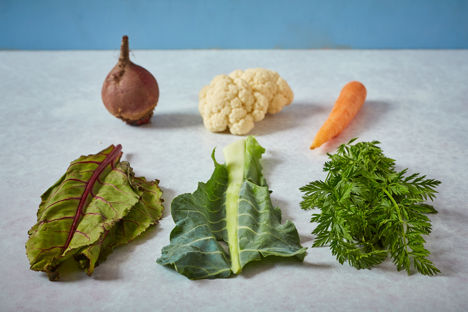
Waste away: leaves and tops
Always trimming and chucking the leaves and tops you find on your vegetables? Don't! Victoria Glass lets us know how to make the most of them and shares three delicious recipes that put them centre stage.
Waste away: leaves and tops
Always trimming and chucking the leaves and tops you find on your vegetables? Don't! Victoria Glass lets us know how to make the most of them and shares three delicious recipes that put them centre stage.
Where you buy your fresh produce will hugely determine the volume of plumage crowning your veg. You’ll find enormous manes on bunches of carrots, radishes, beetroots and turnips in markets and in veg boxes. Celery, cauliflower and broccoli will all have been given less of a crew cut too. Supermarkets tend to trim quite ruthlessly to slow down the rate of spoilage; leaves and tops can turn slimy quickly and draw the moisture out of the veg beneath, but please don’t let this put you off. In fact, a healthy green quill is a strong indicator of freshness and, consequently, quality. Whatever the size of your greens, there are plenty of good meals to be made with them. Once thought of as fit only for pigs’ feed, the world is finally becoming aware of the neglected culinary treasures found in tops and leaves.
It’s worth trimming off these tops as soon as you can to store separately in the fridge, or you can freeze them for later use – both your vegetables and tops will last longer this way. Beet tops can be used as salad leaves, or try radish or Brussels tops in place of other leafy greens. Simply steam or wilt them in a little butter or stock, add them to soups, use them in curries in place of spinach, or try whizzing them in a processor to make pesto or salsa verde.
Beetroot leaves make a great alternative in any recipe that calls for chard – they taste quite similar, belonging, as they do, to the same family. Or, if you find yourself feeling nostalgic for the kale chip craze of 2012, why not try a waste-conscious upcycle by swapping out the kale for veg tops instead. Carrot and radish tops, turnip greens and beetroot leaves are all great in quick pickles made with sugar, salt and rice vinegar, while celery leaves can add a fresh, herbal note to suet dumplings or stews. Celery leaves can also be dehydrated in a dehydrator or low oven, then blitzed with salt to make celery salt – perfect for all your Bloody Mary needs.
The more robust leaves of brassicas, like cauliflower and broccoli, are excellent simply roasted in oil and salt, with added aromatics optional but encouraged (a favourite of mine is ground cumin). The leaves also work brilliantly in stir-fries, or try dipping them in batter before deep-frying to make excellent tempura; they have just the right balance of tenderness and bite. They also work well shredded and tossed in salt and caraway seeds, before being left weighted down to ferment for four to six weeks, to make a delicious sauerkraut-style side.
Most of us are well-versed in the use of bay, curry and kaffir lime leaves in our cooking, but largely ignore the potential bounty in our back gardens or local parks. Dandelion leaves are great in salads (try using them instead of rocket) and nettles are a classic in soups, or as a spinach replacement in spanakopita; once cooked, they lose their sting, but you’ll need a sturdy pair of gloves for picking.
A personal favourite for infusions is blackcurrant leaves. Try steeping blackcurrant or fig leaves in cream or sugar syrup to make fragrant ice creams, sorbets or jellies. You can even use blackcurrant leaves whole to make dolma. Bramble leaves steeped in boiling water make for heady herbal teas and won’t cost a penny, but not everything is fair game in the kitchen. Beware rhubarb and potato leaves, which are poisonous; the latter can even be deadly.
Beyond a few basic precautions, you can save a lot of money and eat very well by using what’s growing wild to supplement the more common leaves and tops from your weekly grocery shop. There is so much flavour to be found in tops and leaves that the only ones missing out will be the pigs. With all these delicious uses, they’ll never be able to get their trotters near them again!


